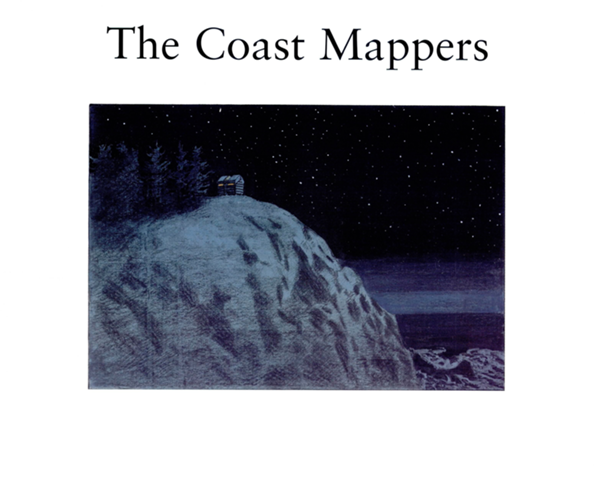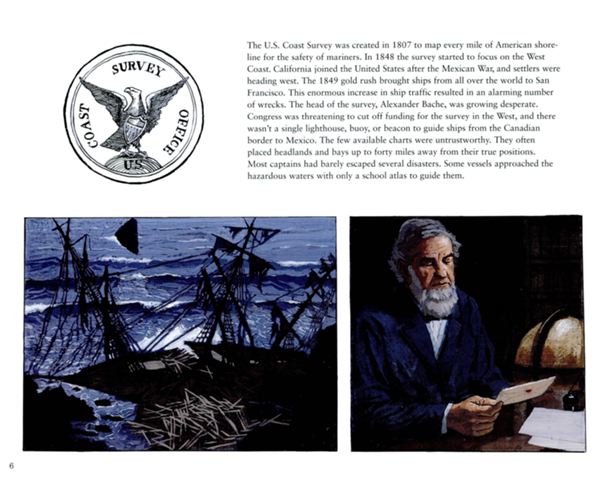
The Coast Mappers



HOUGHTON MIFFLIN COMPANY BOSTON 2004
Walter Lorraine Books
For Mom and Dad
Copyright 2004 by Taylor Morrison
All rights reserved. For information about permission to reproduce selections from this book,
write to permissions, Houghton Mifflin Company, 215 Park Avenue South, New York, New York 10003.
www.houghtonmifflinbooks.com
Library of Congress Cataloging-in-Publication Data
Morrison, Taylor.
The coast mappers / Taylor Morrison,
p. cm.
Summary: Chronicles the difficulties encountered by George Davidson and
others as they attempted to create nautical charts to complete the U.S.
Coast Survey of the West Coast in the mid-nineteenth century.
Includes bibliographical references.
ISBN 0-618-25408-0
I. CartographyPacific Coast (U.S.)History19th century. 2.
SurveyingPacific Coast (U.S.)History19th century. 3. Pacific
Coast (U.S.)Maps. 4. Davidson, George, 1825-1911. [1.
CartographyPacific Coast (U.S.) 2. SurveyingPacific Coast (U.S.) 3.
United States Coast Survey. 4. Pacific Coast (U.S.)Maps. 5. Davidson,
George, 1825-1911.] I. Title.
GA408.S. P 33 M 67 2004
623.89'297dc22
2003013534
Printed in Singapore
TWP 10 9 8 7 6 5 4 3 2
The Coast Mappers
Taylor Morrison


Since the beginning, America has depended on commerce to grow into a powerful nation. Successful commerce relies on the safe passage of ships in and out of harbors. Almost all the things people use every day have traveled over water at some time. Clothes, food, cars, and oil are just a few of the millions of tons of goods that are carried into U.S. ports. However, storms, fogs, and collisions have claimed many victims at sea. Ship captains, passengers, and merchants have always entrusted their lives and precious cargo to maps of American waterways. Who has been making these nautical charts for almost two hundred years?

The U.S. Coast Survey was created in 1807 to map every mile of American shoreline for the safety of mariners. In 1848 the survey started to focus on the West Coast. California joined the United States after the Mexican War, and settlers were heading west. The 1849 gold rush brought ships from all over the world to San Francisco. This enormous increase in ship traffic resulted in an alarming number of wrecks. The head of the survey, Alexander Bache, was growing desperate. Congress was threatening to cut off funding for the survey in the West, and there wasn't a single lighthouse, buoy, or beacon to guide ships from the Canadian border to Mexico. The few available charts were untrustworthy. They often placed headlands and bays up to forty miles away from their true positions. Most captains had barely escaped several disasters. Some vessels approached the hazardous waters with only a school atlas to guide them.

Bache selected George Davidson to take on the job of charting the coast. Davidson had to find the true positions of the major points on the coast to correct existing charts. This meant that he had to conduct a geodetic survey before maps of the entire coast could be made. Bache urged Davidson to do great work under brutal conditions. "Let nothing daunt you," Bache instructed. "Be determined to work hard to succeed, you will succeed!"
On May 5, 1850, three scientistsDavidson, James Lawson, and John Rockwelldeparted from New York on a crowded steamer called the Philadelphia. They traveled down to Central America and journeyed west in canoes and by mule train to Panama. Another steamer, the Tennessee, picked them up and paddled north up the Pacific Ocean. After traveling for more than a month, they finally saw the Golden Gate appear on the horizon.



San Francisco Harbor was crammed with hundreds of empty ships abandoned by frantic gold seekers as they went in search of instant wealth.
Five days earlier a major fire had destroyed the wharf's connection to land. The three surveyors had to carry their baggage over a plank to shore.


Davidson scrambled to find shelter and a place to store all of their valuable instruments. The boom town shocked him. "Here everything is feverish, exciting, maddening, everyone is intoxicated with gold ... Gold! Gold! Gold!" he wrote. He needed to hire workers, but everyone had gold fever. Nobody wanted to earn low pay on a survey crew when he could make a fortune in the mines.
A few months earlier the lust for gold had motivated the worst mutiny in the Coast Survey's history. Five sailors from the Ewing had attacked their commanding officer. They knocked him out and threw him into the water. Luckily, the officer was rescued and revived by British sailors. The mutineers were captured the next day on their way to the gold fields, and the navy hanged two of them for the attempted murder.
Davidson finally found lodging and a ship after a few weeks in the wild city. He decided to begin work at Point Conception. Old "coasties" considered this southern headland the most dangerous to sail around on the West Coast. Bache continued to push Davidson from Washington. "I must have sites for lighthouses at Point Conception," he wrote. The surveyors' instruments and supplies, which together weighed more than a ton, were dumped on the beach at Cojo Bay near the point and had to be lugged up the steep cliffs. Davidson and Lawson carried a cast-iron telescope stand that weighed more than three hundred pounds.

Next page
























